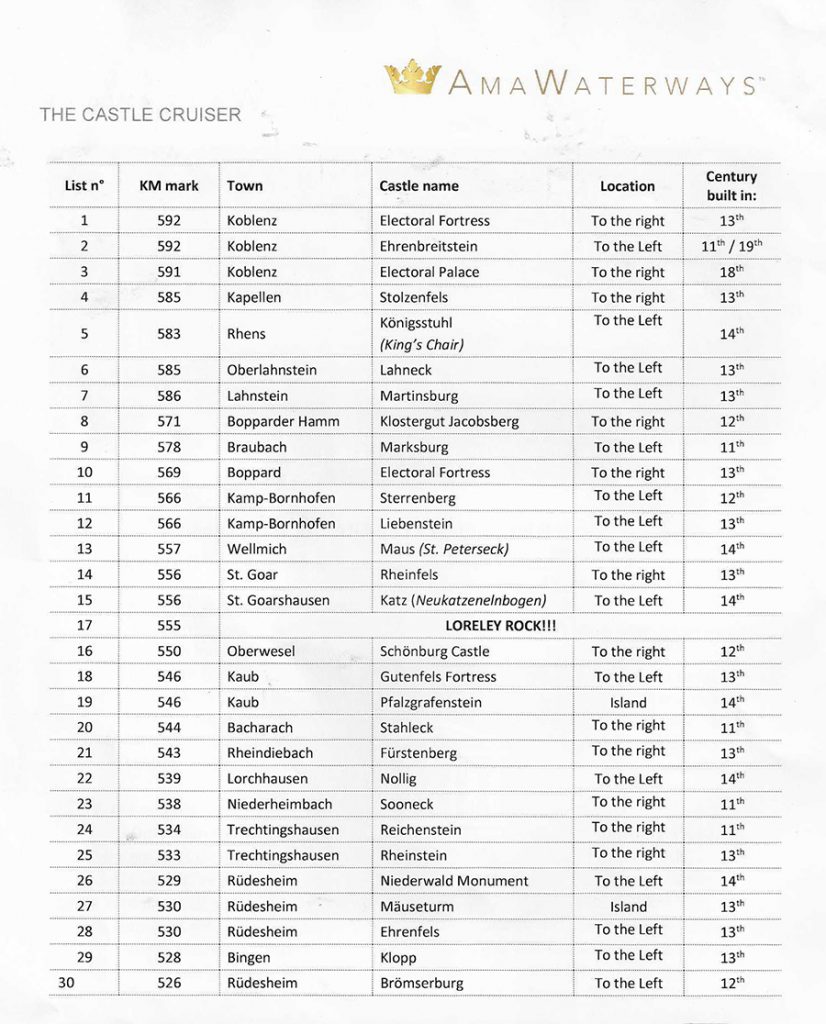AmaWaterways offers numerous river cruises along rivers in Europe, including the Rhine River. The Rhine River is one of the major waterways in Europe, flowing through several countries including Switzerland, Germany, France, Belgium, and the Netherlands. AmaWaterways river cruises let travelers explore the scenic beauty, historical sites, and cultural attractions along the Rhine without having to re-pack and change hotels every day. The only downside of a river cruise is we’re unable to visit the Rhine castles – prime encouragement for a future road trip!
Tales of Terroir: The Unique Rieslings of Moselle and Rhine River
The highlight of a Rhine cruise is the scenic passage through the Rhine gorge with its many castles. The stretch of the Rhine River from Koblenz to Rüdesheim is famous for its picturesque landscapes and the numerous Rhine castles now peaceably dotting the hillsides along the riverbanks. The Rhine has been a major line of engagement since the Roman Empire decided to set it as their farthest borders. I’ve always been fascinated by history and this pathway is rich in historical memories.
When we visited museums in Nuremburg & Prague after our Rhine castle cruise and it helped us in following the complicated history of this area, when the current small towns we visited were major sites of imperial concerns.

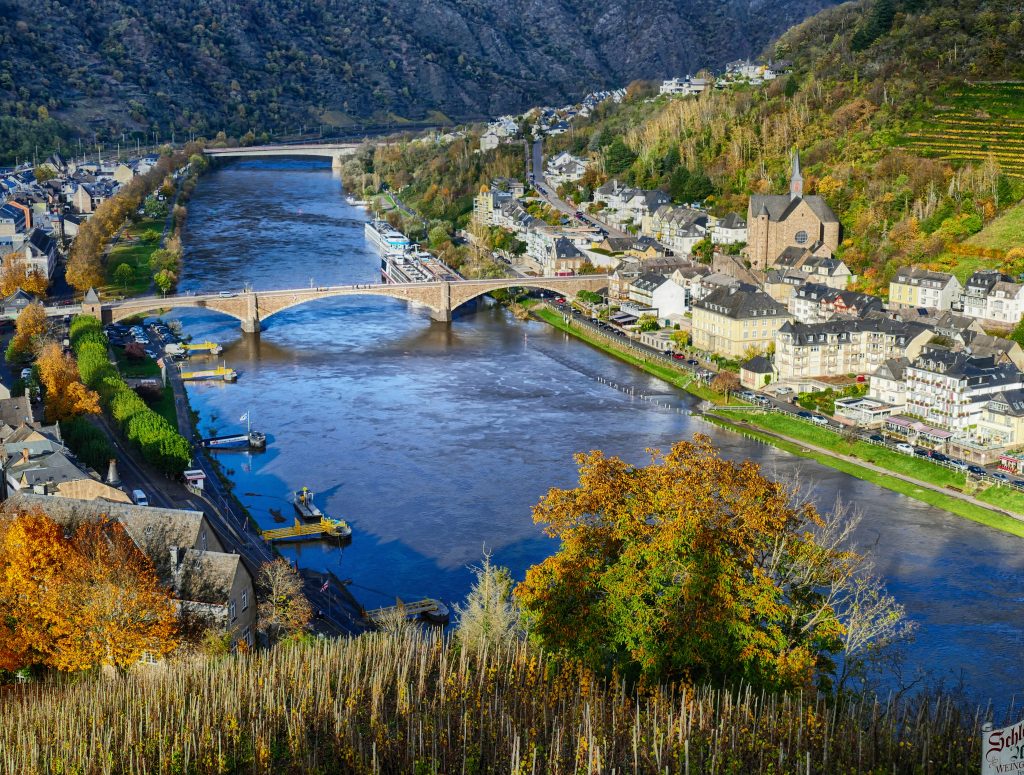
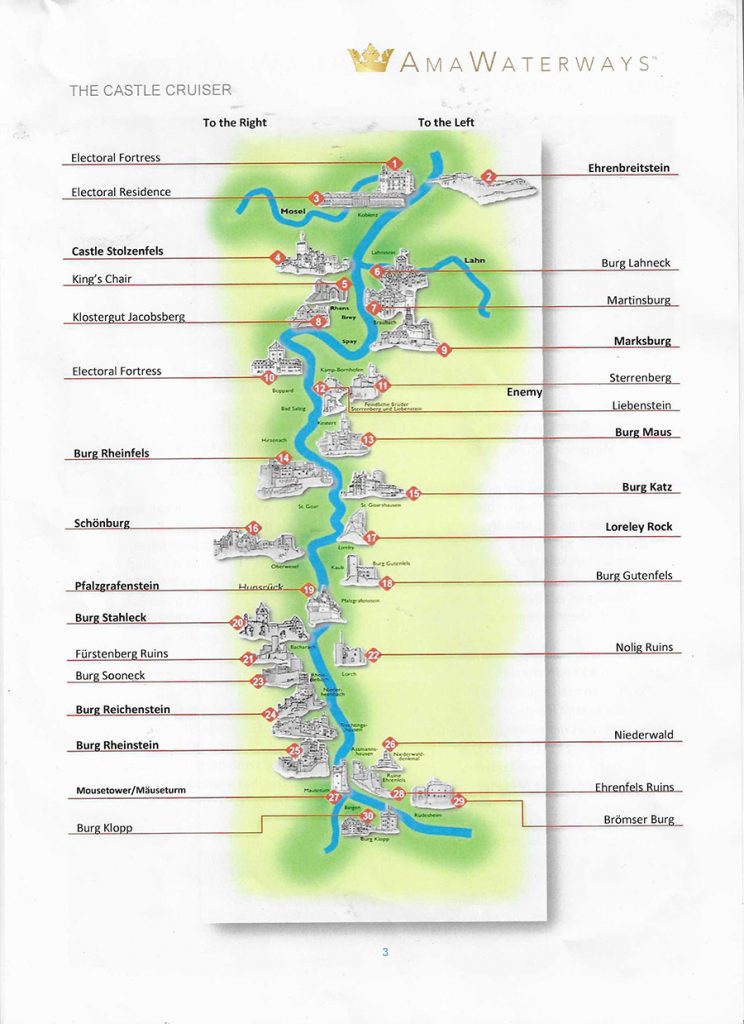
But now let’s view what we find today on our cruise – this was my third voyage thru the Rhine gorge and the first in which I (occasionally) had blue skies.
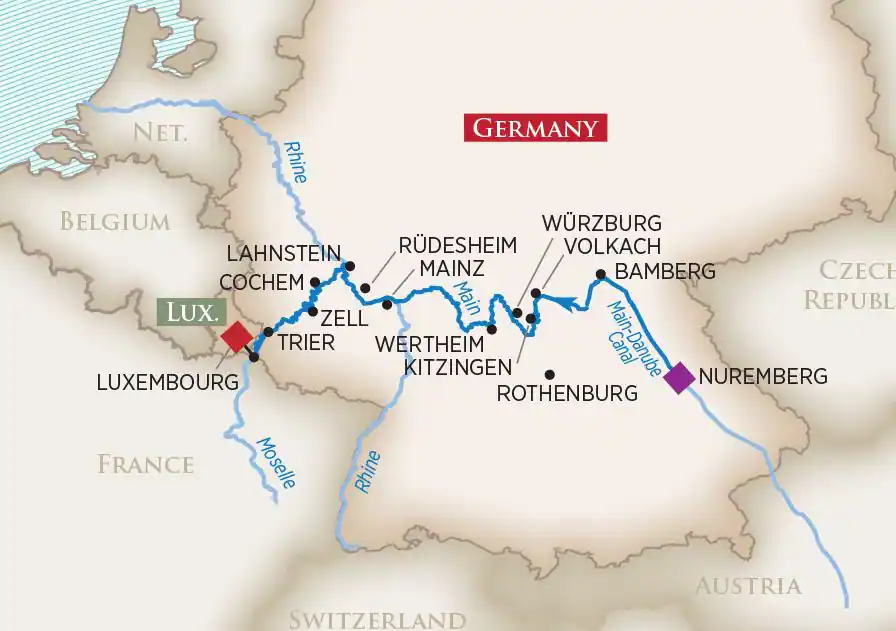
Rhine Castles:
Ehrenbreitstein Fortress (Festung Ehrenbreitstein) – Located in Koblenz, this is one of the largest preserved fortresses in Europe. It offers panoramic views of the Rhine and Moselle rivers. We passed this beautifully lit fortress at night as we moved from the Moselle to the Rhine.
Stolzenfels Castle: (Schloss Stolzenfels) This picturesque castle near Koblenz, Germany sits on a hill overlooking the confluence of the Rhine and Moselle rivers. It’s on a small rocky island called Falkenau, only about 30 meters long and 22 meters wide. It’s strategically position in the middle of the Rhine River allowed it to control and tax passing ships. The castle was built in the 14th century by King Ludwig the Bavarian to enforce these tolls on passing ships.

The castles Liebenstein and Sterrneberg, situated on the long stretch of peaks above Bornhofen are among the most popular Rhine castles

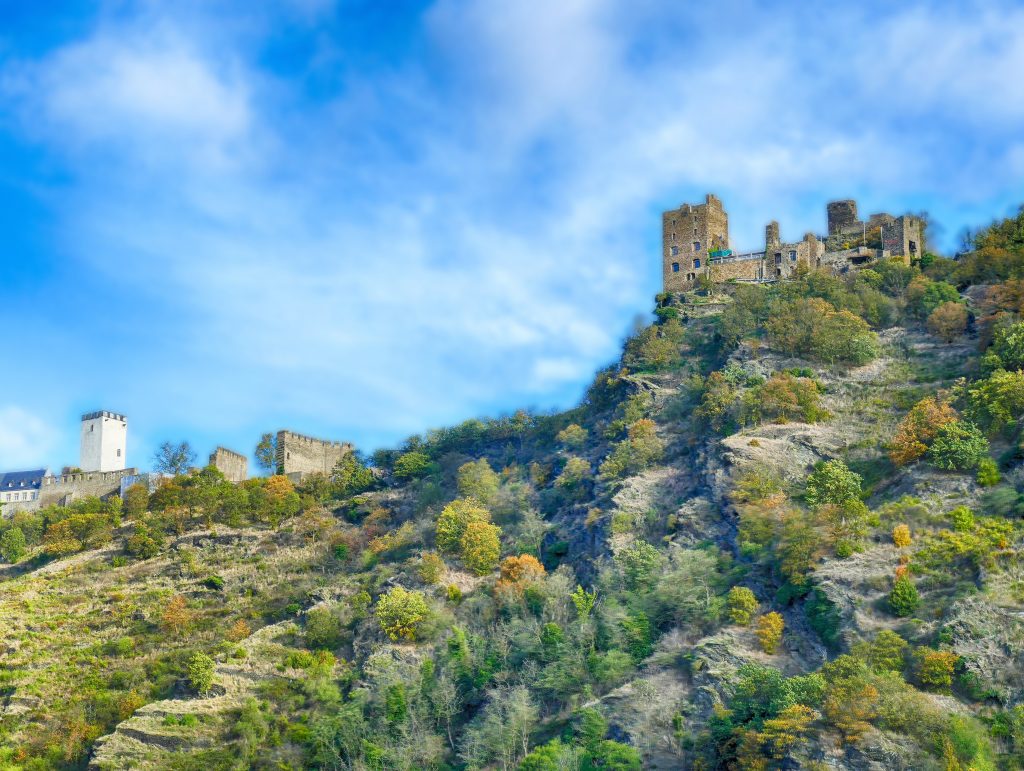
Marksburg Castle (Burg Marksburg) – Located in Braubach, Marksburg is the only hill castle of the Rhine castles that has never been destroyed. It is a prime example of a medieval fortress and now houses a museum. The castle also offers panoramic views of the surrounding landscape and the Rhine Valley.
The Maus and Katz castles, also known as Burg Maus and Burg Katz in German, are two historic Rhine castles in Germany. They are situated on opposite sides of the river and are known for their picturesque views and rich history. Burg Maus is located on the right bank of the Rhine River near the town of Wellmich, in the state of Rhineland-Palatinate, Germany.


The castle was constructed in the early 14th century by the Archbishop of Trier, Balduin of Luxembourg. It was originally built, surprisingly, to enforce toll collection on passing ships and to secure control over the strategic Rhine River traffic. The name “Maus” means “mouse” in German, and it is said to be named after the Count of Katzenelnbogen’s fortress, which was destroyed during the construction of Burg Maus.
Burg Maus is a well-preserved castle with a typical medieval design, including thick defensive walls, towers, and a central courtyard. It offers a commanding view of the Rhine and the surrounding area. The castle now serves as a museum and a venue for events. It offers guided tours and has a restaurant where visitors can enjoy the scenic view of the Rhine.
Burg Katz is located on the left bank of the Rhine River near the town of Sankt Goarshausen, also in Rhineland-Palatinate, Germany. The castle was built in the late 14th century by Count Wilhelm II of Katzenelnbogen. Like Burg Maus, it was primarily constructed to collect tolls from passing ships and to assert control over the river trade.

Burg Katz features a distinctive round keep and a tower, both of which have been rebuilt over the centuries. It also has a central courtyard and defensive walls.: The castle has undergone extensive restoration and now serves as a private residence. It is not open to the public, but visitors can admire its picturesque exterior from the river.
Both Burg Maus and Burg Katz are part of the Middle Rhine Valley, which is a UNESCO World Heritage Site due to its cultural and historical significance, as well as its stunning natural landscape. These Rhine castles are popular tourist attractions, and they contribute to the romantic and picturesque allure of the Rhine River region.
Pfalzgrafenstein is a small, fortified toll castle. It is constructed in a pentagonal shape and is characterized by its defensive walls and tower. The tower, which stands at the center of the castle, served as the living quarters for the castle’s occupants. Its primary function was to control river traffic and collect tolls from passing ships. The tolls were imposed on goods transported along the Rhine, and the revenues were used to maintain and fortify the castle. The castle’s remote location on the island made it difficult for would-be attackers to reach. Access to the castle was only possible by boat, and a special chain system was used to collect tolls from passing ships.

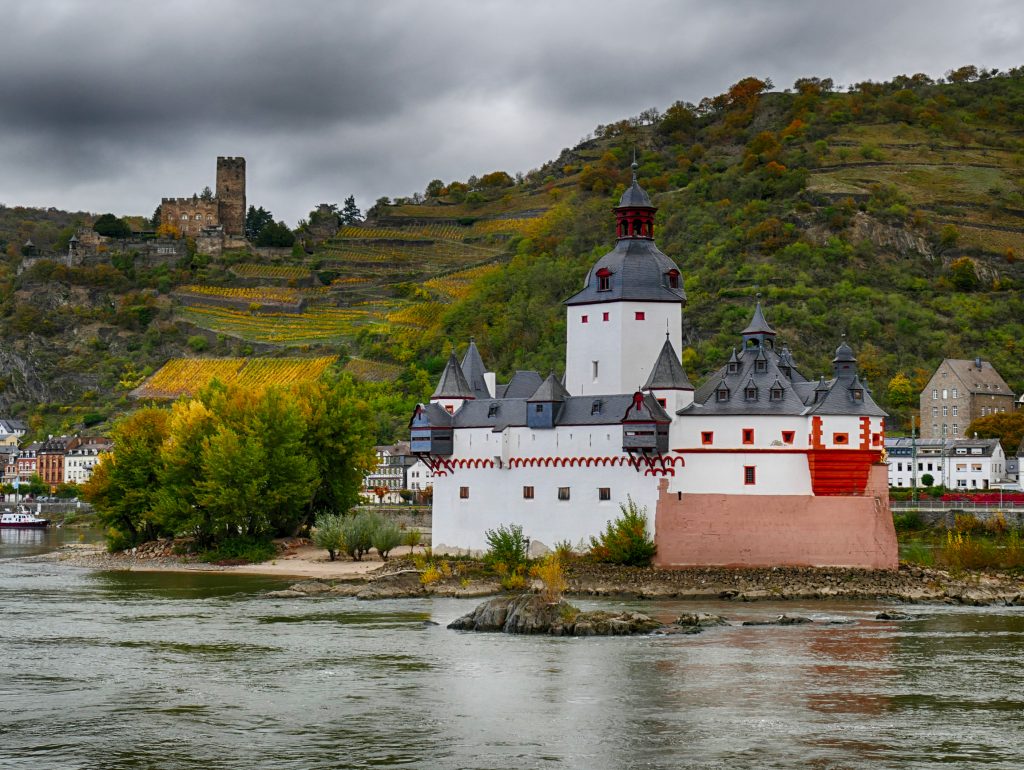
Over the centuries, the castle’s function as a toll station became less important, and it fell into disuse. It was used as a prison for a short period in the 17th century. Later, in the 19th century, it was restored and preserved as a historic monument.
Stahleck Castle, also known as Burg Stahleck, is a historic castle located in the town of Bacharach, in the Rhineland-Palatinate region of Germany. It is situated on a hill overlooking the Rhine River and is a prominent example of medieval military architecture. The castle was built in the 11th century, specifically around the year 1135, by the Archbishop of Cologne, Heinrich I von Schwarzburg. Its primary purpose was to serve as a defensive fortress and toll station along the Rhine River. The strategic location of Stahleck allowed it to control river traffic and collect tolls from passing ships.
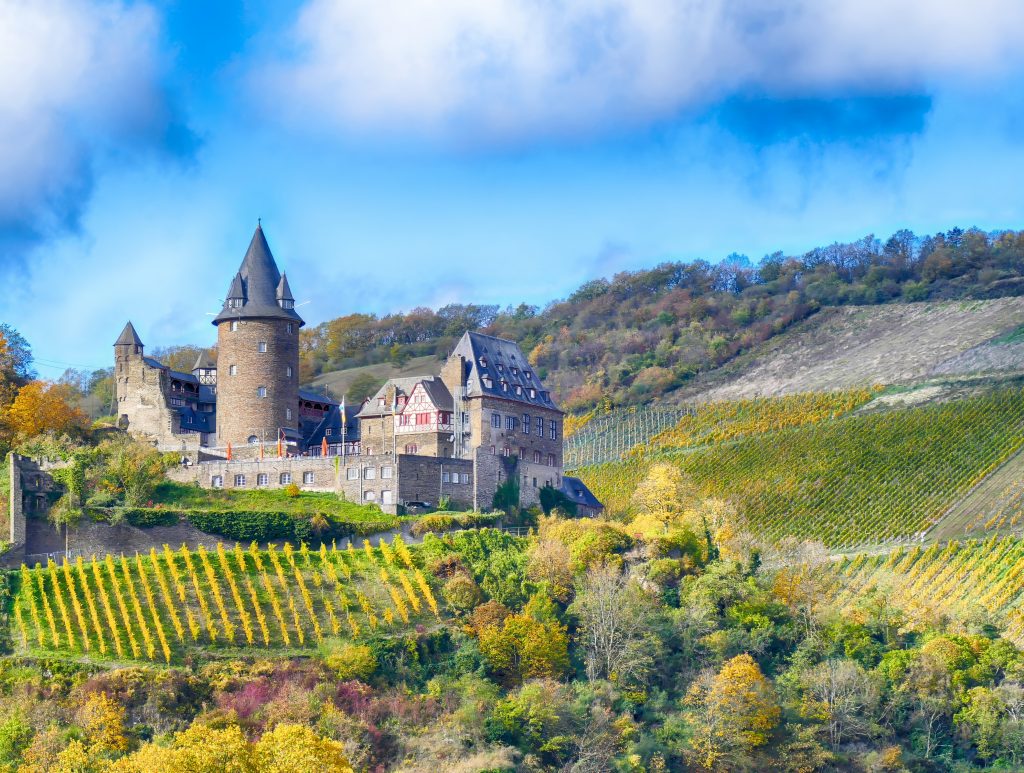
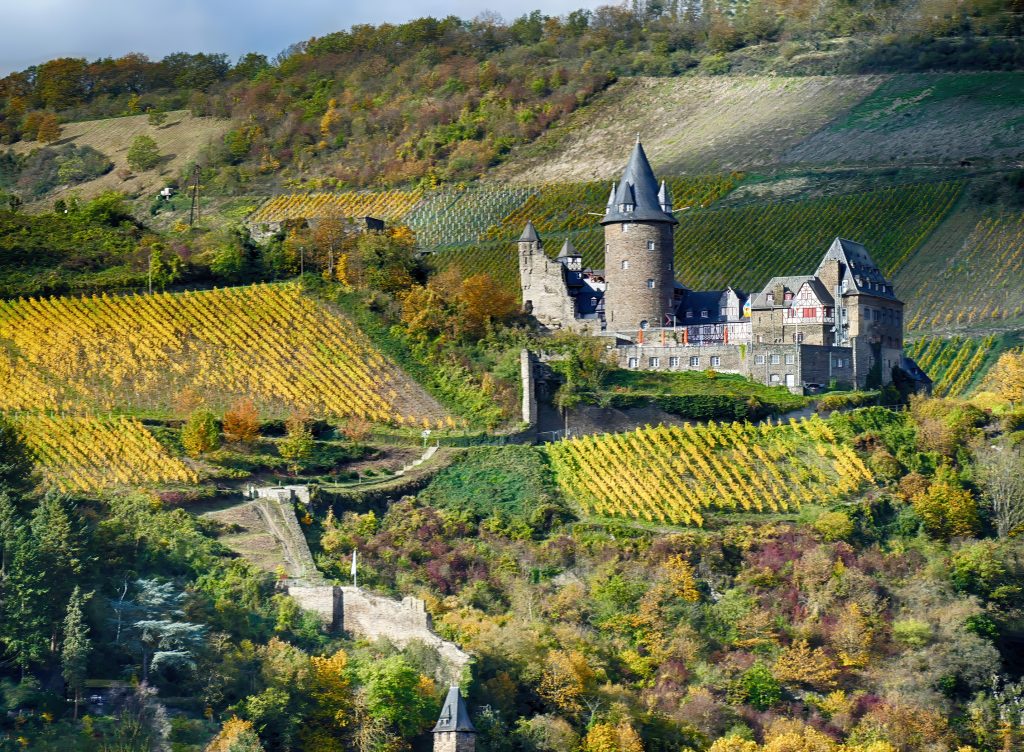
In the 17th century, during the Thirty Years’ War, the castle was partially destroyed by French forces. In the 19th century, it fell into disrepair and was used as a quarry for building materials. In the 20th century, Stahleck Castle was rebuilt and restored. Today, it operates as a youth hostel, providing accommodation for travelers. Its picturesque setting along the Rhine River and its rich history make it a popular destination for tourists interested in medieval architecture and history

Sooneck Castle (Burg Sooneck) – Located near Niederheimbach, this medieval castle has a rich history dating back to the 11th century. It was extensively restored in the 19th century.
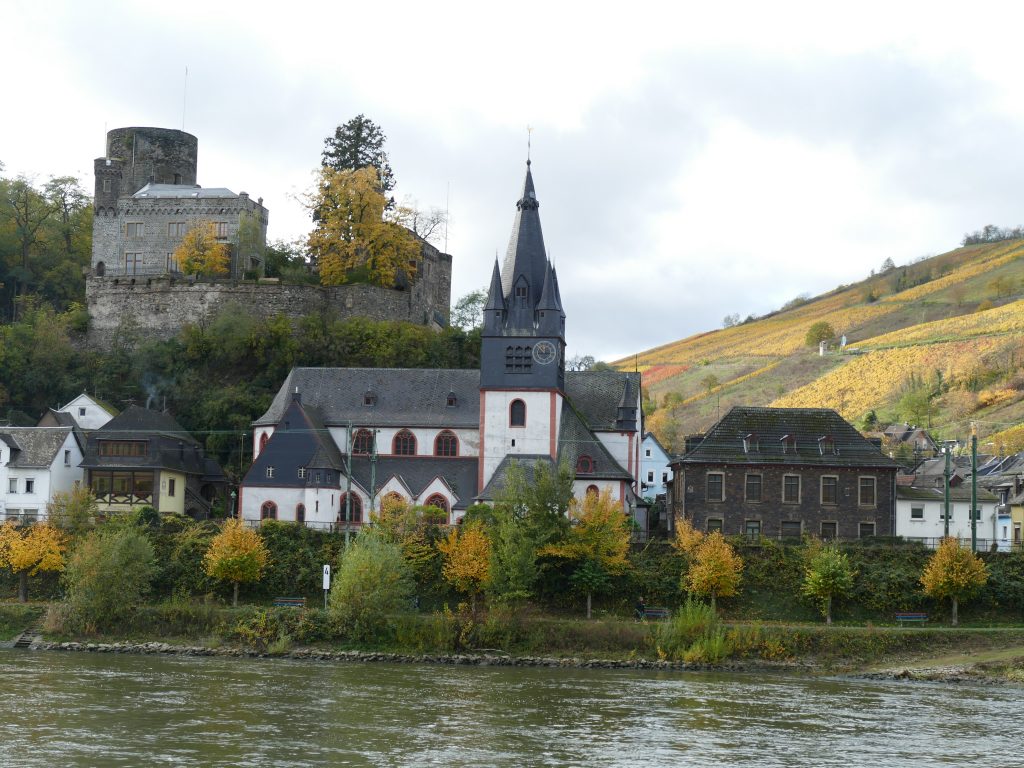
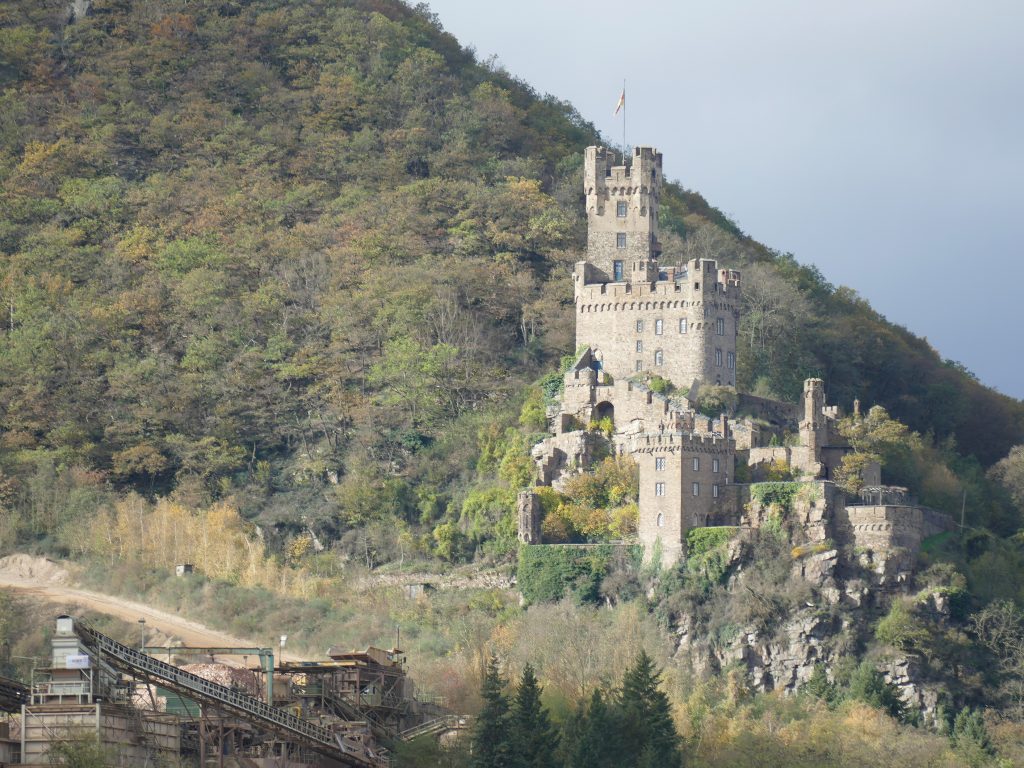
Reichenstein Castle (Burg Reichenstein) aka “Trechtingshausen Castle,” is a medieval fortress located in the Middle Rhine Valley of Germany. It was built in the 11th century and is situated on a hill overlooking the Rhine River. The castle is a fine example of Romanesque architecture and is known for its strategic position, which provided a commanding view of the surrounding area.
Originally constructed as a defensive fortress, Reichenstein Castle has a storied history. It played a significant role in various regional conflicts and served as a residence for noble families over the centuries. The castle features thick stone walls, towers, and battlements, characteristic of the defensive structures of its time. Today, Reichenstein Castle stands as a well-preserved historical site and is open to visitors. It offers a glimpse into the medieval past, showcasing architectural details and providing panoramic views of the picturesque Rhine Valley.

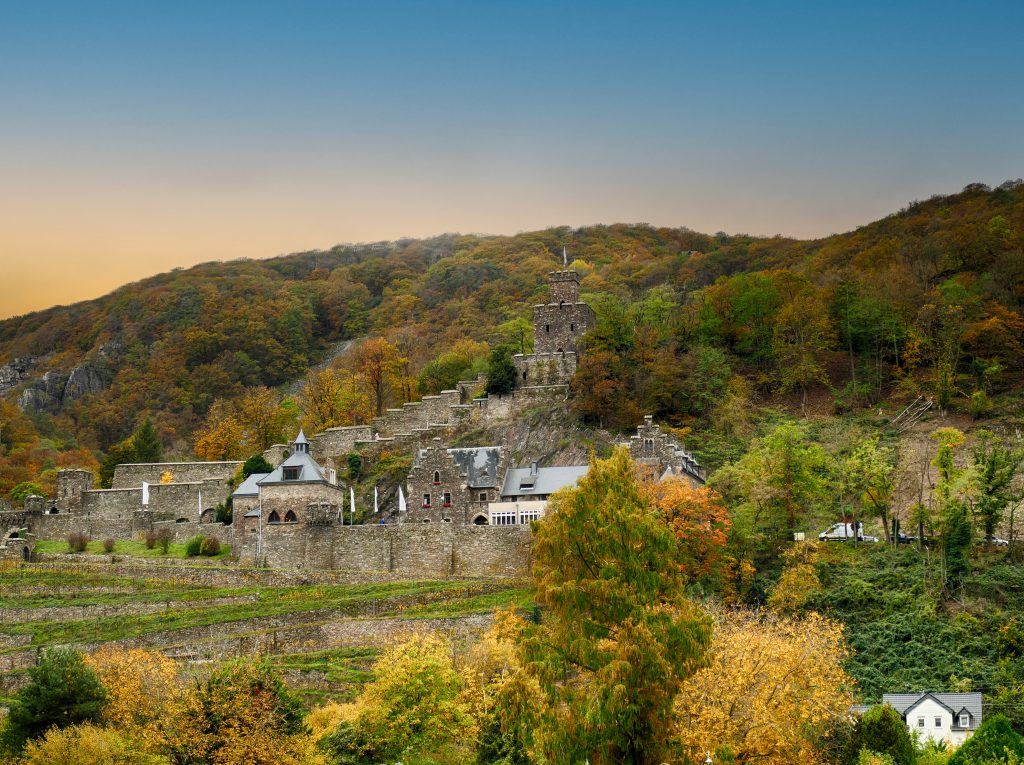
Rheinstein Castle Burg Rheinstein sits between Trechtingshausen, and Rüdesheim. Like Reichenstein, Rheinstein Castle was defensive featuring elements of Gothic and Romanesque architecture, including towers, drawbridges, and a fortified gatehouse. Like many castles in the region, it witnessed a rich history of ownership and military significance. It was involved in territorial disputes and underwent periods of reconstruction and restoration. Today, it stands as an iconic landmark and is open to the public, offering visitors a chance to explore its historic rooms, ramparts, and gardens, all while enjoying breathtaking views of the Rhine River.
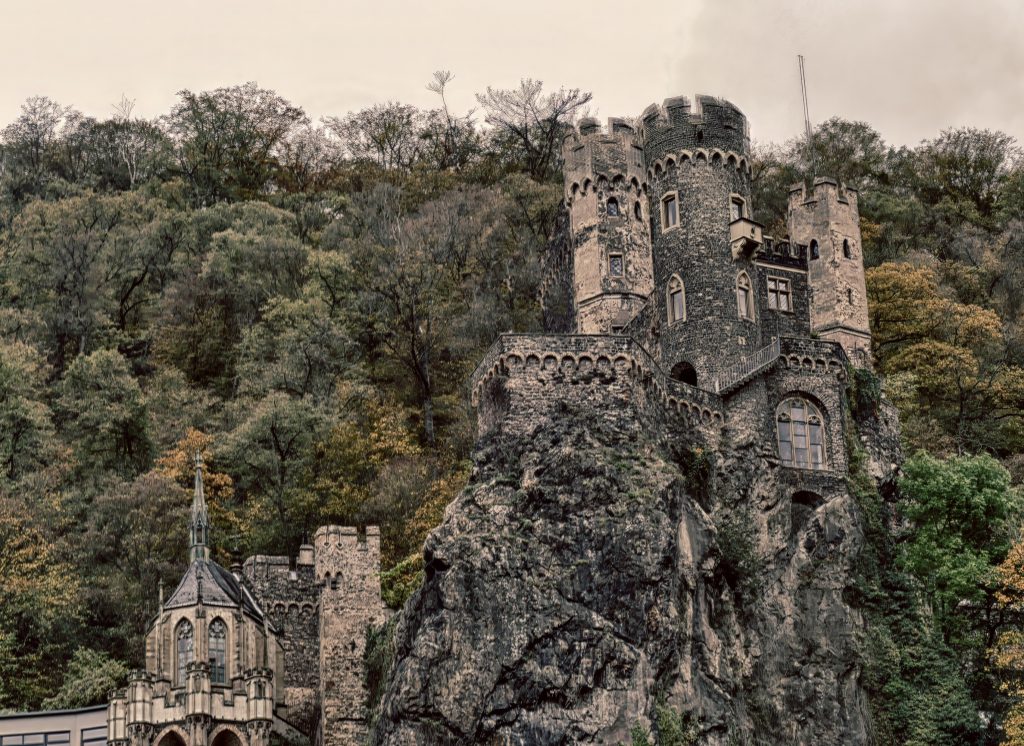

Ehrenfels Castle (Burg Ehrenfels) – Located near Rüdesheim, this castle is in ruins but still retains its commanding presence on the hillside overlooking the Rhine.
Bingerbrück Castle (Burg Klopp) – Situated in Bingen am Rhein, this castle has undergone several reconstructions over the centuries. It is now used as a restaurant and event venue.
These Rhine castles collectively offer a glimpse into the rich history and architectural diversity of the Rhine region. They also contribute to the romantic and picturesque atmosphere that characterizes this stretch of the river. Many of them are open to visitors, providing opportunities to explore their interiors and learn about the fascinating stories behind each castle.
Some further historical background
While most of the Rhine castles were constructed in the 11-14th centuries, 2 Frenchmen had an enormous effect on the Rhine castles in the 17th and early 19th centuries.
Louis XIV, also known as the Sun King, reigned as the King of France from 1643 to 1715. During his rule, he pursued a policy of territorial expansion and sought to consolidate and strengthen his power both within France and in neighboring regions.
One significant event associated with Louis XIV and the Rhine castles is the Nine Years’ War (also known as the War of the Grand Alliance or the War of the League of Augsburg), which lasted from 1688 to 1697. This conflict was a result of various European powers seeking to contain Louis XIV’s expansionist ambitions.
As part of the war effort, French forces under Louis XIV’s command advanced into the Rhineland region, which included the territories along the Rhine River. During this military campaign, many Rhine castles were damaged or destroyed. The primary reason for this destruction was strategic in nature, as it was believed that dismantling these fortifications would weaken the defensive capabilities of the region and make it easier for French forces to control and occupy the area.
This policy of destroying castles as a military strategy was not unique to Louis XIV; it had been employed by various powers throughout history as a means of gaining tactical advantage. However, Louis XIV’s actions in this regard, along with other aspects of his rule, have been subjects of historical debate and scrutiny. XIV was notorious for destroying his ‘own’ French city walls to undercut the chance of rebellion. (Excellent analysis in Aldous Huxley’s under-appreciated ‘The Devils of Loudon’ and the inspiration of one of my favorite movies – Ken Russell’s adaptation “The Devils” with Oliver Reed, Gemma Jones, and Vanessa Redgrave’s nun in need of exorcism, exposing the use of religion in furtherance of political ambitions). Anyway …
It’s important to note that while Louis XIV’s forces did cause significant damage to some castles along the Rhine, not all were destroyed, and many were eventually rebuilt or restored in the subsequent years and centuries. Today, the Rhineland is known for its picturesque medieval Rhine castles, many of which have become popular tourist attractions.
Napoleon Bonaparte embarked on a series of military campaigns that reshaped the map of Europe. His forces often encountered and occupied various regions, including areas along the Rhine River in Central Europe. The Rhine River played its traditional role as a natural barrier and strategic point of interest for many European powers.
One of the notable events related to the Rhine River and Napoleon was the creation of the Confederation of the Rhine in 1806. This was a union of German states under the protection and influence of France, effectively weakening the power of the Holy Roman Empire.
Napoleon also ordered the construction and fortification of several castles along the Rhine, both as defensive structures and symbols of his authority. Some of these castles, such as Ehrenbreitstein Fortress in Koblenz, were extensively modified or expanded during his reign.
Overall, Napoleon’s influence in the region had a lasting impact on the political and territorial configuration of Europe. His actions, including the establishment of the Confederation of the Rhine and the fortification of castles, were part of his broader strategy to consolidate power and expand French influence on the continent.
